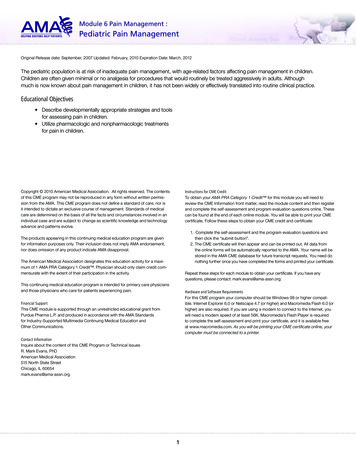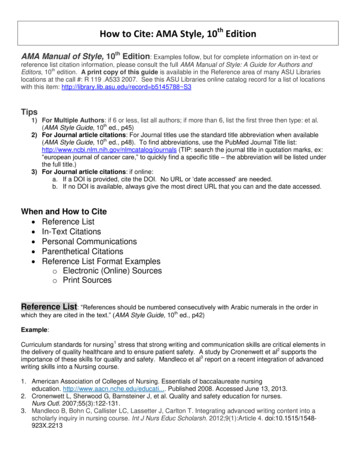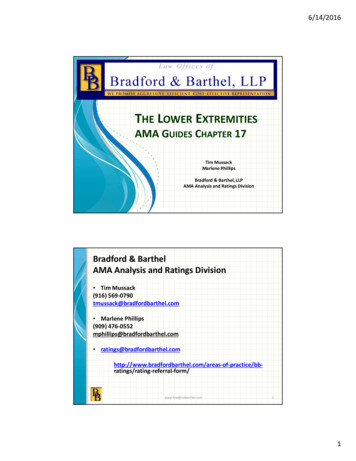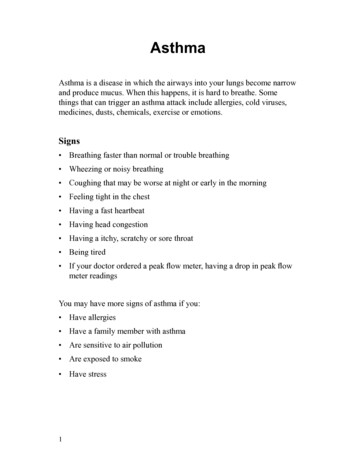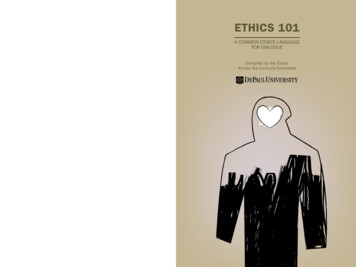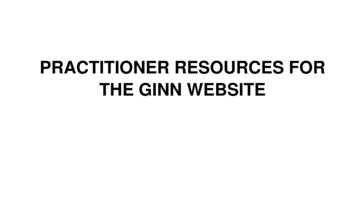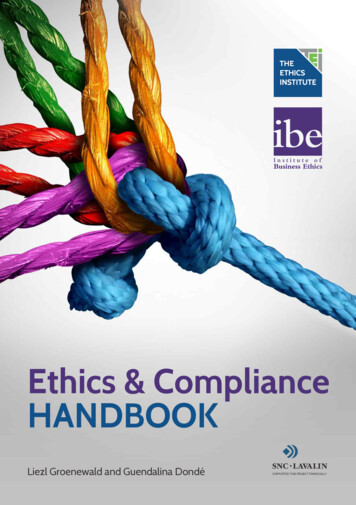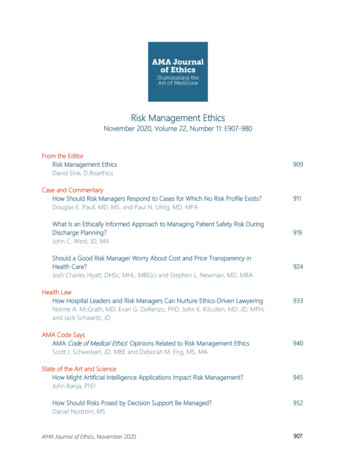
Transcription
Risk Management EthicsNovember 2020, Volume 22, Number 11: E907-980From the EditorRisk Management EthicsDavid Sine, D.Bioethics909Case and CommentaryHow Should Risk Managers Respond to Cases for Which No Risk Profile Exists?Douglas E. Paull, MD, MS, and Paul N. Uhlig, MD, MPA911What Is an Ethically Informed Approach to Managing Patient Safety Risk DuringDischarge Planning?John C. West, JD, MA919Should a Good Risk Manager Worry About Cost and Price Transparency inHealth Care?Josh Charles Hyatt, DHSc, MHL, MBE(c) and Stephen L. Newman, MD, MBA924Health LawHow Hospital Leaders and Risk Managers Can Nurture Ethics-Driven LawyeringNorine A. McGrath, MD, Evan G. DeRenzo, PhD, John K. Kilcullen, MD, JD, MPH,and Jack Schwartz, JD933AMA Code SaysAMA Code of Medical Ethics’ Opinions Related to Risk Management EthicsScott J. Schweikart, JD, MBE and Deborah M. Eng, MS, MA940State of the Art and ScienceHow Might Artificial Intelligence Applications Impact Risk Management?John Banja, PhD945How Should Risks Posed by Decision Support Be Managed?Daniel Nystrom, MSAMA Journal of Ethics, November 2020952907
Medicine and SocietyA Call for Behavioral Emergency Response Teams in Inpatient Hospital SettingsCarmen Black Parker, MD, Amanda Calhoun, MD, MPH, Ambrose H. Wong, MD, MSEd,Larry Davidson, PhD, and Charles Dike, MBChB, MPHWhat Is Ethically Informed Risk Management?Alan J. Card, PhD, MPH, CPHQ, CPHRM956966Art of MedicineBench Reflections on Healing and Patient CareJulia H. Miao and Kathleen H. Miao976ViewpointCaring to VoteAudiey C. Kao, MD, PhD979PodcastManaging Health Care AI “Megarisks”: An Interview With Dr John Banja908www.journalofethics.org
AMA Journal of Ethics November 2020, Volume 22, Number 11: E909-910FROM THE EDITORRisk Management EthicsDavid Sine, D.BioethicsThis issue of the AMA Journal of Ethics is unique—not only because it’s about riskmanagement ethics, but also because the contributors wrote their essays prior to aglobal pandemic that thrust ethical issues of access, justice, and inequity into the mediaspotlight. I wonder how different this content would read if these issues, which are thestock-in-trade of most biomedical ethicists, were at the forefront of the minds of writersand readers alike. Could a chapter be written about health technology and ethics thatdid not touch upon health disparities worsened by lack of equitable access to thattechnology? Or a chapter on health financing that would not point out that, for thosewithout hope of attaining health insurance, discussions about payment for services areand will always be purely academic? Or could any chapter on risk management andethics be written that did not mention poor US public health capacity, lack of supplychain resiliency, and unpreparedness that is laid bare for all to see?My aim is to bring you writings by ethicists who work in the risk management space—orrisk managers who work in the ethics space. And the contributors have done so. ThisAMA Journal of Ethics issue explores the thin gray crescent of overlap between these 2professions. What we find in the product of that vocational Venn diagram is thatethicists remind us to be fair, while risk managers remind us to be prepared to be fair.Differences between those 2 mindsets tend to be flimsy, as practitioners in bothprofessions have internalized ethics in their own ways (ie, what one calls patientautonomy, the other calls patient-centered care). Risk managers tend not to discuss riskin a technical way all that often. It is true that if you attend a risk managementconference, you can find more than a few breakout sessions on funding captiveinsurance programs, bond debt obligations, or even bundling and transferring claimsrisk. But if you head out to the lobby of that conference hotel, discussions you overhearwill likely be about personal aspects of difficult claims, complex cases, or human errorand how to make health care safer for patients. This issue reveals that risk managershave their own language but that many share with ethicists a need to prepare anorganization, its policies, its practice, and its clinicians to meet the conditions in whichhealth care can be just and safe for everyone.David Sine, D.Bioethics is the chair of the Department of Bioethics at Kansas CityUniversity of Medicine and Biosciences in Missouri. He is also a certified professionalhealth care risk manager and a former federal executive with experience in multipledisciplines, including enterprise risk management, organizational ethics, high reliability,AMA Journal of Ethics, November 2020909
and patient safety. He earned a doctorate in biomedical ethics from Loyola UniversityChicago.CitationAMA J Ethics. 9.Conflict of Interest DisclosureThe author(s) had no conflicts of interest to disclose.The viewpoints expressed in this article are those of the author(s) and do notnecessarily reflect the views and policies of the AMA.Copyright 2020 American Medical Association. All rights reserved.ISSN 2376-6980910www.journalofethics.org
AMA Journal of Ethics November 2020, Volume 22, Number 11: E911-918CASE AND COMMENTARYHow Should Risk Managers Respond to Cases for Which No Risk ProfileExists?Douglas E. Paull, MD, MS and Paul N. Uhlig, MD, MPAAbstractRapid innovation makes some devices available for patient implantationprior to extensive preclinical trials. This article reviews information thatrisk managers can utilize to help patient-subjects and clinicianresearchers make informed decisions about new device implantation inthe absence of preclinical trial data. Novel devices should be regardedby risk managers as sources of unknowns with potential for proceduralcomplications and other harms. Risk-benefit analyses during informedconsent should include patient-subjects’ preferences, experience of theimplanting surgical team, disclosure of conflicts of interest, andpostprocedure follow-up planning. Checklists can help risk managersfacilitate critical conversations and decision making about whether toimplant devices with no extant risk profile.CaseMM is a 60-year-old man with hydrocephalus. His life was saved and his symptomsimproved after Dr N implanted a shunt. Like many patients with shunt valves, MMexperiences complications at the surgical site, the most pressing of which is the shuntvalve’s extrusion from the scalp wound. Dr N examines MM’s scalp and remarks, “You’reone of the patients who happens to have a lot of problems with their shunts. What youreally need is a custom-made implant. If I could give you one, it would probably decreasechances of the shunt’s failure, help mitigate skin breakdown on your scalp, and preventthe natural contours of your cranium from becoming deformed. I think you’d be a lothappier with a custom-fit shunt, if you agree to have me remove this one and replace it.You’d be the first patient to have a customized cranial implant. If you’d like to talkfurther about this, we can schedule some time tomorrow to talk about it more. In themeantime, I can present your case to my colleagues and get their ideas, too.”MM agreed to revisit Dr N’s clinic the following day. In the morning, beforemultidisciplinary rounds, Dr N presented MM’s case to the team at what team memberscall their weekly “innovation meeting,” to discuss whether, when, and how to integratenew devices, materials, or techniques into practice. The team includes surgeons,surgical nurses, anesthesiologists, nurse anesthetists, case managers, and a riskmanager. Dr N clarifies that MM’s shunt valve would first be removed and then aAMA Journal of Ethics, November 2020911
temporary shunt would be placed. MM would take a 14-day course of antibiotics. Then acontralateral craniectomy would accommodate implantation of the shunt valve systemthat the manufacturer would customize for MM’s cranial measurements.Team members at the meeting exchanged questions and responses. The risk managertook notes to share with colleagues in the hospital’s office of general counsel and withother risk managers and left the meeting feeling concerned, as numerous questionsabout MM’s safety remained unanswered—and perhaps unanswerable—until the first-inhuman implantation of this device was complete.CommentaryGrowing demand for and explosive growth of technology led to US Food and DrugAdministration (FDA) approval of more than 500 000 device models by the late 1990s.1Regulatory approval processes for new implantable devices differ from those for newmedications and are not as rigorous.1,2 Devices deemed “substantially equivalent” toexisting approved devices can be brought to market without clinical trials prior to firsthuman use if approved through the FDA’s 510k exemption process, despite beingsupported by only a limited amount of data.1,3 Variability in training and experience ofthe implanting team, variation in individual patient-subject preferences and risktolerance,4 and possible conflicts of interest add additional layers of complexity tobalancing patient safety with the need for innovation. Risk managers have critical rolesin helping address decisions that patients and care teams must make about whether,when, and how to implant novel, untested devices. This commentary locatesintroduction of new devices within a framework of ethical principles in health care andintroduces a decision matrix for evaluating new device implantation from an ethicalperspective.Clinical Risk-Benefit AnalysisCerebrospinal fluid (CSF) shunts are lifesaving devices for patients with hydrocephaluscaused by tumors, hemorrhage, or normal pressure hydrocephalus. However, morbidityof CSF shunt implantation is significant. Mechanical dysfunction and infection affect atleast 17.2% and 6.1% of patients, respectively.5 The overall shunt revision rate has beenestimated at 23.3%, with most revisions occurring within 6 months of the indeximplantation.5 Mortality for revision surgery is much higher than for first implantations(11.9 % vs 6.1%, respectively), and need for revision alone increases the incidence ofsubsequent shunt revision 9-fold.5,6 A new device, which could possibly decrease therisk of complications and shunt revision, could offer significant potential benefits for thispatient.Shunt customization involves embedding a rigid plastic casing made to fit the contoursof a specific patient’s skull. Two possible benefits of a low-profile customized shuntimplantation are less scalp pressure and fewer dehiscence-related complications andrevisions. Similar technology has already been utilized by neurosurgeons for other typesof implanted devices, such as deep brain stimulators.6 These potential benefits appearsignificant in the case, in large part because the patient has already experienceddehiscence and a need for revision, which, as noted above, could increase this patient’smorbidity and mortality risk. Identifying specific subpopulations of patients who couldbenefit most from implantation of a novel device is a key next step in MM and Dr N’srisk-assessment process.4912www.journalofethics.org
Other risk factors to consider are whether the shunt and casing composition are likethose of other devices used in neurosurgery, whether the surgical team is experiencedin performing comparable procedures, and how risk of novel shunt placement mightcompare to risk of traditional shunt placement after a course of antibiotics. Materiallikeness of new to approved devices for which safe risk profiles have been establishedand analogous surgical experience are 2 of the most important elements in a riskmanager’s evaluation of risk in a case like this one.6Ethical Risk-Benefit AnalysisNew device implantation requires commitment to executing informed consent processesin ways that express respect for patient-subject autonomy. Patients and their familiesmust be made aware of the rationale for using a new device for which there is little or noextant risk profile, the surgical team’s experience with this or similar devices,alternatives such as implanting a device for which a risk profile is known and accepted,and potential conflicts of interest.3,7 Special consideration must be given to the lack ofclinical evidence about a new device, gaps in knowledge about safety, and need forpostimplant surveillance. Risk managers can help inform conversations about noveldevice implantation benefits and risks, identify patients or subgroups of patients thatcould benefit most from novel device implantation, and provide available information tobuild a risk-benefit profile for the device.4Patient preferences. Patient perspectives on risk tolerance, for example, can differ fromthose of other stakeholders (eg, clinicians, manufacturers, regulators) for many reasons.In the case, a patient might choose to proceed with the new shunt in part due to thecosmetic appeal of the lower profile and an expectation of improved quality of lifeassociated with this feature of the new device, whereas practitioners might focus moreon technical or procedural considerations. Moreover, different patients are likely to havedifferent attitudes about maximum acceptable risks and minimal acceptable benefits aswell as different tolerance levels for uncertainty.4 Having already experienced failure of atraditional shunt, the patient in the case might be more tolerant of uncertainty andchoose the new shunt, especially if the risk-benefit profiles of the new and traditionaldevices otherwise seem or are expected to be similar. On the other hand, because thenew device requires removal of a small portion of skull to allow implantation of the novelembedded customized implant, the patient might not choose to take on additional orunknown risks of serious postoperative complications, such as epidural hematoma.Perioperative care planning. When patient-subjects have capacity to make decisions,their wishes should be prioritized over advance directives or medical (physician) ordersfor life-sustaining treatment.8 Updating advance care planning documents to expresspatient-subjects’ wishes and values is important, since patient-subjects can losedecision-making capacity during a procedure, illness, or hospitalization.9 Do-notresuscitate (DNR) orders and policies must be navigated carefully when a patientsubject undergoes implantation of a new device, due to increased risk of cardiac orrespiratory arrest.10 Deliberating about whether and when (especially during anestheticairway intervention) a DNR order should be perioperatively suspended or continued10must include patient or surrogate input. Decision making is easier when potentialbenefits of the novel device appear likely to—and potential risks appear less likely to—motivate expressed goals of care and when an advance directive fits the situation well.9If conflict arises about how to interpret a patient-subject’s wishes as represented inadvance planning documents, for example, the clinical care team should obtain anethics consultation.8AMA Journal of Ethics, November 2020913
Anatomic location. Implanting a novel device in or around a patient-subject’s brainobliges stakeholders to consider how a patient’s identity and well-being can beaffected,11 especially if that device can be accessed or controlled by third parties. Forexample, shunts might be programmable to prevent over- or underdrainage ofcerebrospinal fluid, especially in patients with normal pressure hydrocephalus.12Previous studies suggest that gaps between a physician-researcher’s understanding anda patient-subject’s perception of risks deserve attention and underscore the importanceof effective communication.13 A risk manager can help elicit reflection, clarify concerns,and illuminate perspectives among all involved in decision making.Commitment to transparency. Conflicts of interest, including financial conflicts andthose related to the prestige of innovation, create a need for transparency about theexperience and abilities of implanting team members and for disclosures about theirpersonal and professional stakes in novel device implantation. Risk managers can helpestablish a relational environment in which these concerns can be discussed and inwhich any relevant data can be illuminated, considered, and addressed. One possibleformat for these discussions is interprofessional collaborative rounds, wherein clinicalcare team members, patients, and their families discuss a care plan and establish ashared mental model.14 Risk managers, clinical teams, patients, and familiesincreasingly have access to databases of outcomes for related procedures and, as aresult of the Sunshine Act, access to public databases of payments from devicemanufacturers to clinicians.3Surveillance and communicating evolving knowledge. In new device implantation, a richpreclinical record of experience and evidence is missing, so a risk-profile is also missing,which creates a gap in knowledge for patient-subjects and clinician-investigators.3 Evenapproved devices can later be found to have previously unsuspected or unknowncomplications. A clinical team and organization have an ethical obligation to discussproviding or arranging for postimplantation surveillance to capture any safety issues thatbecome apparent through patient-subjects’ living with the novel device.Postimplantation surveillance thus should be discussed during an informed consentprocess. All stakeholders, including the patient-subject, should be engaged insurveillance and ongoing disclosures of potential conflicts of interest. Patients,clinicians, and manufacturers should report complications—and certainly adverseevents—in the US Food and Drug Administration Manufacturer and User Facility DeviceExperience database or to the Medical Product Safety Network.3ChecklistThe authors have developed a checklist tool (see Table) to set the stage for informedconsent or refusal conversations among stakeholders and prompt revelation of factorsthat can help motivate ethically informed decisions among patient-subjects and theclinical team. Higher scores yielded by use of the tool could be interpreted as supportinga decision to implant a new device for which there is no extant risk-profile. Lower scoreswould suggest ethical concerns and a need for pause and might prompt a risk managerto recommend an ethics consultation to help address those ethical concerns. Thischecklist could be applied to the above case.914www.journalofethics.org
Table. Checklist Tool for Ethically Implanting New Devices With Limited Clinical Trial DataaFactorRegulatoryPotentialBenefitsPotential RisksDeviceSurgeon/Implanting TeamPatientItemNo.MaximumPointsThisPatient155FDA approval255IRB approval354Significant potentialbenefits function andquality of life,reduction in morbidity,and improved survivalcompared to currentavailable deviceFewer potential benefits ofnew device compared tocurrent available device453Benefits long-lastingTime course unknown553New device either hassimilar expected risk orincreased risk doesnot include seriousharm compared tocurrent device(s)New device significantlyincreases risk of seriouscomplication or death654Any potential newcomplications aremanageableNew complicationsintroduced are difficult totreat750Non-CNS locationLocated near brain855Functionality similar todevices in useNovel functionality955Not accessibleAccessible to third parties1053Implantationprocedure similar toother procedures inroutine clinical useImplantation methodsdiffer substantially fromthose currently in use1155Has considerableexperience implantingsimilar devicesLess experience withsimilar devices andimplantations1255Has undergoneadditional training bythe vendor with thenew deviceNo or limited additionaltraining with new device1354No conflicts of interestwith the vendor anddevicePotential conflict ofinterest (eg, royalties, paidspeaker for devicemanufacturer)1455Belongs tosubpopulation ofpatients with diseasemost likely to benefitNo subpopulation morelikely to benefit known orpatient does not belong tothe subpopulation likely tobenefit the mostAMA Journal of Ethics, November 2020Evidence of GreaterFavorabilityEvidence of LesserFavorabilityInvestigational deviceexemption (eg,emergency)915
PostimplantSurveillance/CommunicationPlanTotal ScorePatient preferencesknown and include:Patient preferencesunknown or patientuncomfortable with:1553 Acceptance ofmaximum possibleincrease in risk Maximum possibleincrease in risk1653 Acceptance ofminimal possibleincreasedbenefit Minimal possibleincreased benefit1753 Acceptance ofdegree of uncertaintyassociated with newdevice Degree of uncertaintyassociated with newdevice1855Implanting team ororganization has thecapacity to provideindividual surveillanceMinimal capacity toprovide individualsurveillance1955Patient able/desires toparticipate in follow-upBarriers to follow-up2055Processes in place tomonitor implants inother patients andcommunicateoutcomes to thispatientUnable to provide globalfollow-up andcommunication10080Abbreviations: CNS, central nervous system; FDA, Food and Drug Administration; IRB, institutional review board.a Users may customize this tool by assigning more or less weight to different items.References1. Ventola CL. Challenges in evaluating and standardizing medical devices inhealth care facilities. P T. 2008;33(6):348-359.2. Pane J, Coloma PM, Verhamme KM, Sturkenboom MC, Rebollo I. Evaluating thesafety profile of non-active implantable medical devices compared withmedications. Drug Saf. 2017;40(1):37-47.3. Muskens IS, Gupta S, Hulsbergen A, Moojen WA, Broekman MLD. Introduction ofnovel medical devices in surgery: ethical challenges of current oversight andregulation. J Am Coll Surg. 2017;225(4):558-565.4. Medical Device Innovation Consortium (MDIC). Patient Centered Benefit‐RiskProject Report: A Framework for Incorporating Information on PatientPreferences Regarding Benefit and Risk Into Regulatory Assessments of NewMedical Technology. http://mdic.org/wpcontent/uploads/2015/05/MDIC PCBR Framework Web1.pdf. Published2015. Accessed May 6, 2019.5. Korinek AM, Fulla-Oller L, Boch AL, Golmard JL, Hadiji B, Puybasset L. Morbidityof ventricular cerebrospinal fluid shunt surgery in adults: an 8-year study.Neurosurgery. 2011;68(4):985-994.6. Gordon CR, Wolff A, Santiago GF, et al. First-in-human experience withintegration of a hydrocephalus shunt device within a customized cranial implant.Oper Neurosurg (Hagerstown). 2019;17(6):608-615.916www.journalofethics.org
7. Ross S, Weijer C, Gafni A, Ducey A, Thompson C, Lafreniere R. Ethics, economicsand the regulation and adoption of new medical devices: case studies in pelvicfloor surgery. BMC Med Ethics. 2010;11:14.8. American Medical Association. Opinion 5.2 Advance directives. Code of MedicalEthics. vance-directives.Accessed April 4, 2020.9. Talebreza S, Widera E. Advance directives: navigating conflicts betweenexpressed wishes and best interests. Am Fam Physician. 2015;91(7):480-484.10. Margolis JO, McGrath BJ, Kussin PS, Schwinn DA. Do not resuscitate (DNR)orders during surgery: ethical foundations for institutional policies in the UnitedStates. Anesth Analg. 1995;80(4):806-809.11. Harmon SH, Haddow G, Gilman L. New risks inadequately managed: the case ofsmart implants and medical device regulation. Law Innov Technol.2015;7(2):231-252.12. Lollis SS, Mamourian AC, Vaccaro TJ, Duhaime AC. Programmable CSF shuntvalves: radiographic identification and interpretation. AJNR Am J Neuroradiol.2010;31(7):1343-1346.13. Sherlock A, Brownie S. Patients’ recollection and understanding of informedconsent: a literature review. ANZ J Surg. 2014;84(4):207-210.14. Clay AM, Parsh B. Patient and family-centered care: it’s not just for pediatricsanymore. AMA J Ethics. 2016;18(1):40-44.Douglas E. Paull, MD, MS is a board-certified general and cardiothoracic surgeon. He isan assistant professor at the Georgetown University School of Medicine in Washington,DC, where he teaches patient safety leadership in a graduate-level program. He alsoserves as a field representative for the Accreditation Council on Graduate MedicalEducation’s Clinical Learning Environment Review program. He trained at New YorkHospital-Cornell Medical Center and the University of North Carolina. His interests andpublications encompass surgery, patient safety, and simulation.Paul N. Uhlig, MD, MPA is a board-certified cardiothoracic surgeon and an associateprofessor in the Department of Pediatrics at the University of Kansas School ofMedicine-Wichita. He is also a field representative for the Accreditation Council onGraduate Medical Education’s Clinical Learning Environment Review program. Hisprofessional interests include collaborative care with active engagement of patients andfamilies, interprofessional education, experiential learning, and patient safety. Hisresearch utilizes social science approaches to study and transform health care practiceculture.AMA Journal of Ethics, November 2020917
Editor’s NoteThe case to which this commentary is a response was developed by the editorialstaff.CitationAMA J Ethics. 1.Conflict of Interest DisclosureThe author(s) had no conflicts of interest to disclose.The people and events in this case are fictional. Resemblance to real events or tonames of people, living or dead, is entirely coincidental. The viewpoints expressedin this article are those of the author(s) and do not necessarily reflect the views andpolicies of the AMA.Copyright 2020 American Medical Association. All rights reserved.ISSN 2376-6980918www.journalofethics.org
AMA Journal of Ethics November 2020, Volume 22, Number 11: E919-923CASE AND COMMENTARYWhat Is an Ethically Informed Approach to Managing Patient Safety RiskDuring Discharge Planning?John C. West, JD, MAAbstractHospital discharge planning for patients who might not be safe athome— particularly those leaving against medical advice—can requirerisk managers to navigate the complex intersection of tort law, federaland state regulations, and clinical ethics. An overarching duty is toensure that a patient is as safe as possible in the environment to whichthe patient is being discharged, although it’s not always possible toformulate a safe discharge plan. When patients have decision-makingcapacity, they can make a decision to be in an environment that’s notsafe. When patients do not have decision-making capacity, it is notalways legally permissible to hold them against their wishes to keepthem in a safe environment, so some kind of discharge plan must bemade. This article considers the role of a risk manager in navigating thisset of circumstances.CaseRQ is a 32-year-old man with end-stage multiple sclerosis (MS). He lived independentlyuntil 5 years ago, when his condition became worse and he had to be hospitalizedseveral times. RQ was then cared for in his home by his parents and sister, with supportfrom a home care agency. Early in his most recent hospitalization, RQ suffered severerespiratory distress, was intubated, and was placed on a ventilator. RQ’s body languageadamantly and persistently expressed that he did not want to be intubated. But Dr C, apulmonologist in the intensive care unit (ICU), expressed confidence that RQ’s currentrespiratory condition was temporary, with a solid chance of remission. No advancedirective existed in RQ’s electronic health record (EHR), and Dr C was convinced that RQlacked decision-making capacity at this time. Dr C and RQ’s parents agreed thatventilator support should continue.As RQ’s hospitalization continued, his condition deteriorated, and he became moreagitated. RQ was sedated, a line was inserted for hyperalimentation (intravenousnutrition), and a tracheostomy tube was placed. He suffered several nosocomialinfections, including methicillin-resistant staphylococcus aureus. After 80 days in theICU, RQ’s condition stabilized enough for him to be weaned from the ventilator. After 81days, RQ plugged his tracheostomy tube to speak; he stated clearly and deliberately, “IAMA Journal of Ethics, November 2020919
don’t want any more machines and I don’t want any more treatment here or anywhere. Iwant to go home, and I want to be by myself.”To Dr C’s and other caregivers’ frustration, however, RQ’s father insisted that allresuscitative measures, including mechanical ventilation, be implemented when RQ’srespiratory status deteriorated again, which Dr C suspected could happen at any time.Based on their most recent conversations with RQ, Dr C and RQ’s other caregiversagreed that an order to limit life-sustaining treatment should be placed in his EHR. Dr Cexplained to RQ’s father, “RQ has decision-making capacity now, and he understandsthe risks of going home, so it’s reasonable for us to explore discharge planning at thistime.”Enraged, RQ’s father pointed at Dr C’s chest and said, “Well, he can’t go home.Something will happen to him and he’ll be hurt, and I promise you’ll be the first one wename when we sue this hospital.” Following this clear threat of legal action from RQ’sfather, RQ’s care team now meet regularly with Mr J, one of the hospital’s riskmanagers.When discussing the timing and terms of RQ’s discharge, Mr J stated, “Even with fullassessment of his home environment, his deteriorating condition makes anywhere he’salone unsafe. Allowing him to exercise his right to self-determination is just too risky forus in this case. I wouldn’t recommend discharge to any place other than a skillednursing facility.”Members of the team wondered what to do next.CommentaryThere are a number of avenues by which the issue of safe discharge can be addressed,but none of them offer an optimal solution to the problem. Discharging a patient is oftena simple process: the patient has been restored to health and can return home to safelycarry on with his or her life. While this covers the vast majority of cases, it does not coverall cases. The cases not covered by the foregoing scenario can be t
Stephen L. Newman, MD, MBA Health Law How Hospital Leaders and Risk Managers Can Nurture Ethics -Driven Lawyering 933 Norine A. McGrath, MD, Evan G. DeRenzo, PhD, John K. Kilcullen, MD, JD, MPH, and Jack Schwartz, JD. AMA Code Says AMA Code of Medical Ethics' Opinions Related to Risk Management Ethics 940
